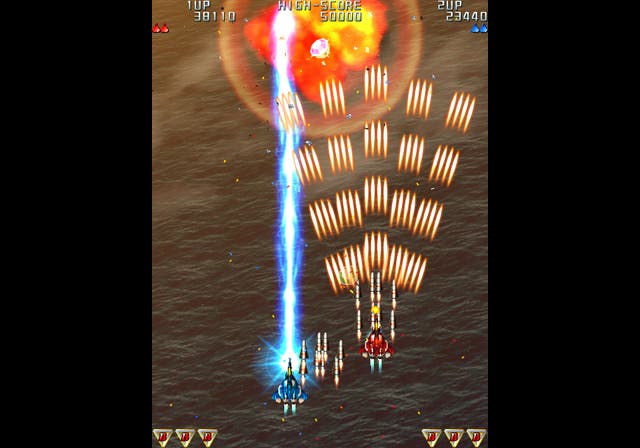Raiden III
Raiders of the lost art.
Two weeks ago, on a gas-mark 4 Friday night, Eurogamer squeezed past the hunched backs of fifty-odd Japanese twenty-somethings to explore a bustling arcade in Eastern Shinjuku. Two days previously, the latest update to Virtua Fighter V had been released in Japan and, as a result, the bravest and best of Tokyo's beat 'em up aficionados had sunk into the belly of this grimy building to wage fresh pixel war against each other.
Squat Atomiswave candy cabinets, the likes of which England will never see, divided the room into efficient Japanese rows. In the half-light, white CRT bonfires pulsed, trebly pips and bleeps swarming around bright pink and green Sanwa sticks: the opposite of where Eurogamer is used to being. High-heeled loligoth girls stood idly by each machine, bursting pink bubblegum balloons of attitude, studied nonchalance shrouding quick and narrow, boy-rating eyes.
Past these new machines deeper, back along a timeline of arcade history we walked - Third Strike, Alpha 3, Samurai Shodown then Street Fighter 2 - on into a quieter corner. Here, at an older, yellower machine sat an thinner, darker boy clunking a solitary 100 yen coin into Seibu Kaihatsu's latest shoot 'em up: Raiden III. Head leaned back, a cigarette, lit but undragged, hung from a bolshy bottom lip. Pretending not to notice us he waited until we were paused behind him before hitting the start button. For the next twenty minutes, Virtua Fighter V be damned. Using nothing but heightened reflexes, three lives, one coin and a lifetime's concentration this boy weaved Raiden's classic Mark II fighter plane over steel-carpeted future cities, seas and space, ducking, weaving and counter-attacking waves of enemies with a nerd boxer's poise.

It's almost a year since Raiden III was released in Europe onto PlayStation 2 by 505 Street. Two years, if you're talking about when first published the game onto Japanese shelves. But, just a few weeks ago, the game was finally released in the US, which reminded Eurogamer what a frightfully forgetful collective it can sometimes be. So, if it makes things easier for you, look at this as an up-to-the minute import review of an exotic new title. But look: If you've recently stood behind a talented arcade player and watched him one credit a shoot 'em up, you'll understand why we've chosen to right the oversight and review this game.
Already some of you will be irritated by the apparent waste of wordcount in this review on a seemingly superfluous anecdote. But arcade shoot 'em ups are all about the drama. If you fail to understand this - the blisters, the weeks of dedicated practice, the showboating, the carpal tunnel and up close and personal glory - you'll never understand or appreciate why this PS2 conversion does the things it does in the ways it does.
Play any shoot 'em up in the arcade and you're doomed from the first coin. You pay to postpone the ending but the videogame always wins in the long run. Arcade games are designed differently to home console or PC games. A home title earns its money at point of sale - once you have it home its job is to assure you it's been money well spent by telling you that you're fast, smart, good and talented at videogames with repeated rewards. Conversely, a Japanese shmup is designed to take your money coin by coin, minute by minute as you play it. And it does this by telling you you're slow, stupid, terrible and worthless at videogames with repeated punishments.
But the good ones are those, which, at the same time as they steal from you, convince you you're in with a chance. They offer that casino-esque glimmer of hope that, with the right luck, skill or practice, you might just be able to beat the system and win the game in one go. Just one more go.

